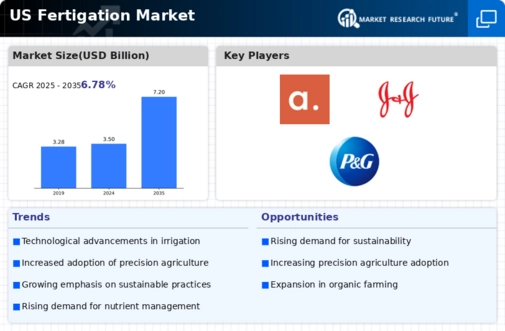Government Support and Incentives
Government initiatives and financial incentives play a crucial role in shaping the fertigation market. Various federal and state programs are designed to promote sustainable agricultural practices, including the use of fertigation systems. For instance, the US Department of Agriculture (USDA) has introduced grants and subsidies aimed at encouraging farmers to adopt innovative irrigation technologies. These programs not only help reduce the initial investment costs associated with fertigation systems but also promote environmental stewardship. As a result, the market is witnessing an increase in adoption rates, with estimates suggesting that government support could lead to a 15% growth in the fertigation market over the next five years. This support is essential for fostering a more sustainable agricultural landscape.
Increasing Agricultural Efficiency
The drive towards enhancing agricultural efficiency is a pivotal factor influencing the fertigation market. Farmers are increasingly adopting fertigation systems to optimize water and nutrient delivery, which can lead to improved crop yields. In the US, the adoption of precision agriculture techniques has been on the rise, with a reported increase of 20% in the use of advanced irrigation technologies over the past few years. This trend indicates a growing recognition of the benefits of fertigation systems, which can reduce water usage by up to 30% while ensuring that crops receive the necessary nutrients. As agricultural practices evolve, the fertigation market is likely to see sustained growth, driven by the need for more efficient farming methods that align with modern agricultural demands.
Rising Demand for High-Quality Produce
The growing consumer demand for high-quality and organic produce is significantly impacting the fertigation market. As consumers become more health-conscious, there is an increasing preference for fruits and vegetables that are not only fresh but also free from harmful chemicals. Fertigation systems enable farmers to deliver precise amounts of nutrients, which can enhance the quality and taste of produce. In the US, the organic food market has seen a remarkable growth rate of 10% annually, further driving the need for efficient nutrient delivery systems. This trend suggests that the fertigation market will continue to expand as farmers seek to meet consumer expectations for quality while maintaining sustainable practices.
Water Scarcity and Conservation Efforts
Water scarcity is an escalating concern in many regions of the US, prompting a shift towards more efficient irrigation practices, including fertigation. The increasing frequency of droughts and water restrictions has led farmers to seek solutions that maximize water use efficiency. Fertigation systems, which can reduce water consumption by up to 50%, are becoming increasingly attractive as a means to conserve this vital resource. The urgency of addressing water scarcity issues is likely to propel the fertigation market forward, as farmers recognize the necessity of adopting technologies that not only enhance crop productivity but also contribute to sustainable water management practices.
Technological Integration in Agriculture
The integration of advanced technologies in agriculture is a driving force behind the growth of the fertigation market. Innovations such as IoT (Internet of Things) devices, sensors, and data analytics are transforming traditional farming practices. These technologies enable real-time monitoring of soil conditions and crop health, allowing for more precise application of water and nutrients through fertigation systems. In the US, the market for agricultural technology is projected to grow by 25% over the next few years, indicating a strong trend towards modernization in farming. This technological shift not only enhances operational efficiency but also supports sustainable agricultural practices, thereby fostering the expansion of the fertigation market.














Leave a Comment